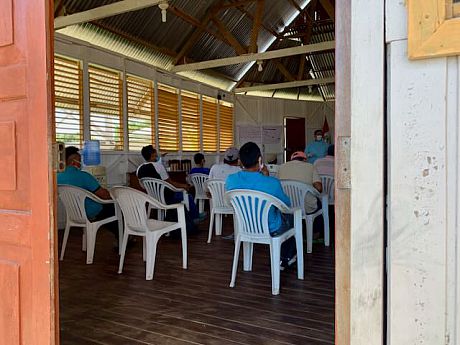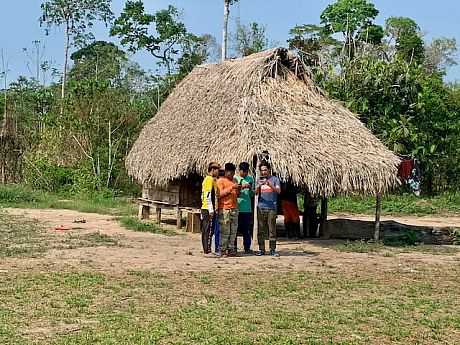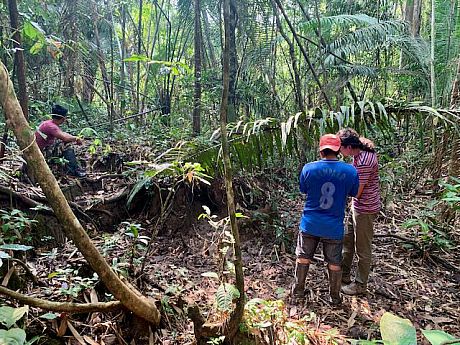Collaborative governance of protected areas in Peruvian Amazonia
Overview
Bringing together a range of institutional, policy and research partners in Peru, the project is focused on the significant issue of securing the meaningful participation of indigenous people and communities in forms of environmental governance. In order to strengthen participatory processes, the project team will develop and test a collaborative, adaptive and reflexive monitoring tool which will enable more transparent, inclusive, and horizontal conservation regimes that have positive impacts on both people and forests while supporting the recognised rights of indigenous peoples to prior consultation and participation in policy decisions and forms of governance. This new project will complement other research undertaken by Principal Investigator (PI) Dr Killick and Co-Investigator (Co-I) Dr Peck while building on and taking forward the joint work they have done on previous SSRP-funded projects.
- Sustainable Development Goals
This project examined the following SDGs:
SDG 5 – Gender Equality
SDG 10 – Reduced Inequalities
SDG 13 – Climate Action
SDG 15 – Life on Land
SDG 16 – Peace, Justice and Strong InstitutionsFind out more about the UN Sustainable Development Goals.
Project description
Building on prior SSRP-funded collaborative work with indigenous peoples and institutions in Peru, this project is focused on enabling a more open and inclusive form of governance of environmentally important forested areas. Specifically, with Peruvian society now re-opening this new funding will allow for the development and implementation of a collaborative monitoring tool that has been designed during the pandemic but not yet put into practice.
 A participatory meeting under COVID conditions
A participatory meeting under COVID conditions
The work will focus on four Communal Reserves in Peru’s Amazon that are co-managed by Peru’s Protected Areas Service (SERNANP) and local indigenous organisations (ECAs). Our work has found often conflicting ideas between these governmental and local institutions over their conservation goals and governance regimes. While privately recognised, these different perspectives are seldom discussed openly, which is commonly interpreted by communities as a lack of transparency. Our research has also found governance capacity gaps among ECAs as well as indigenous communities more generally, with public participation further reduced by the pandemic. These factors challenge the effective and equitable governance of these socio-culturally and environmentally important spaces and thus their transformational potential as a rights-based approach to conservation.
In response, a framework of participatory exercises and reflexive feedback processes has been developed as well as a package or ‘tool’ that will enable ECAs and local indigenous populations to monitor and discuss the protected areas and to produce collaborative and adaptive responses to new and ongoing social and environmental issues. The approach’s innovation lies in its emphasis on two forms of participation: (i) its co-development with Asociación Nacional de Ejecutores de Contrato de Administración de Reservas Comunales del Perú (ANECAP), ECAs and community representatives, and (ii) its implementation by ECAs and their partners rather than by external evaluators. In this context the tool provides a framework for adaptive and reflexive learning by bringing together stakeholders to collaborate in planning the implementation of activities, collectively monitor those activities, and learn from the impact of their actions to adapt future work to the lessons that arose from the monitoring process. The key point is for ECAs and the communities they represent to critically reflect on their shared challenges and collaboratively design possible solutions.
 Community Monitoring on the Purús River, Perú.
Community Monitoring on the Purús River, Perú.
The tool is a product of the project team's ongoing collaborations with SERNANP, the National Organisation of ECAs (ANECAP) and the Center for International Forestry Research (CIFOR) along with researchers and students at two universities in Peru: Pontificia Universidad Católica del Perú (PUCP) and Universidad Nacional Intercultural de la Amazonía (UNIA). Its potential for improving the transparency, inclusivity and equity of conservation regimes is recognised by SERNANP and ANECAP which, after completion of this pilot phase, will adopt it as an official tool for Communal Reserves. While the foundations of the tool are laid, this funding allows for it to be further developed and tested in a series of workshops and interviews with key actors on the ground.
Timeline and funding
| Timeline |
March 2022-July 2022 |
|---|---|
| Funding |
SSRP funding (£11,600) |
Expected outcomes and impacts
- Final development and testing of the tool with four ECA
- Publication of an official guide with ANECAP and SERNANP for use within those organisations as well as for wider dissemination
- National multi-stakeholder workshop in Lima to present, discuss and disseminate findings
Socioculturally, this project will help to
- Promote inclusive conservation and development policy options which value the well-being and collective experiences of indigenous communities;
- Improve conservation regimes by facilitating more informed, transparent and accountable governance reflecting socio-cultural values of indigenous communities;
- Facilitate indigenous peoples’ knowledge and experience of institutional structures and processes of governance, empowering them to achieve a sustainable future;
- Enhance the capacities of indigenous leaders and government officials to engage in reflection, cross-cultural dialogue and social learning;
- Strengthen the cultural confidence and pride of indigenous peoples within communities, society and the academic and development institutional frameworks.
In terms of economic outcomes and impacts, the team expects to support protected areas as sites of sustainable livelihoods for their inhabitants, ensuring economic needs are balanced with social welfare and environmental protection. The research also involves capacity development of indigenous people in assessing forms of governance towards positive impacts on their individual economic prospects, and those of their institutions and communities.
This is an academically and socially innovative project, which can also influence policy making in Peru. The tool will be applicable in other contexts where local populations are involved in the governance of protected areas. Moreover, the project’s collaborative approach will ensure equitable inclusion of the most socially and politically marginalised members of Peruvian society including rural populations, indigenous people, women, elderly people and young people. It will enhance the visibility of rural Amazonian populations that are disadvantaged by limited exposure in research, policy and academic spheres.
 Recording Forest Resources with Mastanawa people
Recording Forest Resources with Mastanawa people
The team
- Principle Investigator (PI) and Co-Investigators
Principal Investigator
- Dr Evan Killick, School of Global Studies
Co-Investigators
- Dr Mika Peck, School of Life Sciences
- In-country partners
- Fermin Chimatani, Asociación Nacional de Ejecutores de Contrato de Administración de Reservas Comunales del Perú (ANECAP), Peru
- Marco Antonio Arenas Aspilcueta, Servicio Nacional de Áreas Naturales Protegidas por el Estado (SERNANP), Peru
- Deborah Delgado Pugley, Pontificia Universidad Católica del Perú (PUCP), Peru
- Anne Larson, Center for International Forestry Research (CIFOR), Peru
Where we worked
Peru.